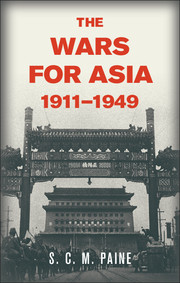Book contents
- Frontmatter
- Contents
- Maps
- Acknowledgments
- Technical Note
- Part I Fear and Ambition Japan, China, and Russia
- PART II Nested Wars
- 5 Flashback to 1911 and the Beginning of the Long Chinese Civil War
- 6 Regional War
- 7 Global War
- 8 The Final Act of the Long Chinese Civil War
- 9 Conclusion
- Chronology
- Notes
- Bibliography
- Index
9 - Conclusion
Civil War as the Prologue and Epilogue to Regional and Global Wars
Published online by Cambridge University Press: 05 September 2012
- Frontmatter
- Contents
- Maps
- Acknowledgments
- Technical Note
- Part I Fear and Ambition Japan, China, and Russia
- PART II Nested Wars
- 5 Flashback to 1911 and the Beginning of the Long Chinese Civil War
- 6 Regional War
- 7 Global War
- 8 The Final Act of the Long Chinese Civil War
- 9 Conclusion
- Chronology
- Notes
- Bibliography
- Index
Summary
轉戰千里
Revolving wars for 1,000 miles.
(Incessant warfare.)Japan, the United States, and Russia all intervened in the long Chinese civil war but none achieved their desired long-term goals. Japan sought a productive extension of its empire. The United States envisioned a unified, democratic, and capitalistic China. Russia planned for a dependent and dependable client state. Instead, Japanese military strategy produced the very outcome it was designed to prevent. By destroying the Nationalists’ conventional forces while the Chinese Communists cultivated rural support behind Japanese lines, the strategy positioned the Communists to win the final chapter of the long Chinese civil war to produce a unified, Communist, and viscerally anti-Japanese China. U.S. diplomacy in the 1930s instead of deterring, accelerated Japanese expansion to transform a regional war in China into a two-front global war for the United States. Likewise, Japanese attempts to deter the United States from intervening in Asia produced U.S. intervention on an unprecedented scale. Meanwhile, U.S. aid to the Nationalists caused long-term Chinese Communist antipathy without any compensating Nationalist loyalty. In the short term, Russia alone achieved its intermediary goal to set up China in 1936 to fight Japan in 1937 so that Japan and Germany would not combine against Russia in a fatal two-front war. Brokering the Communist-Nationalist Second United Front was Stalin’s greatest diplomatic achievement because it saved communism in Russia. In the long term, however, Chinese animosity toward Russia built as Chinese leaders slowly realized that Russia’s China policy was designed to meet Russian not Chinese goals and that these goals, despite their shared faith in communism, often sharply diverged.
FEAR, AMBITION, DILEMMAS, NESTED WARS, AND PIVOTAL DECISIONS
Leaders in Japan, China, and Russia were all motivated by powerful ambitions and deep-seated fears, which produced intractable dilemmas. Within living memory Japanese leaders had transformed a traditional society into a great power. They were intent upon retaining Japan’s place among the powers and carving out a role in international relations commensurate with its economic and political achievements at home. With the Great Depression they feared for Japan’s economic well-being in a world of escalating tariffs and spreading communism among the world’s unemployed. In particular, they feared Russian expansion in China and attempts to take advantage of the debilitating civil war that had broken out upon the fall of the Qing dynasty.
- Type
- Chapter
- Information
- The Wars for Asia, 1911–1949 , pp. 271 - 300Publisher: Cambridge University PressPrint publication year: 2012



